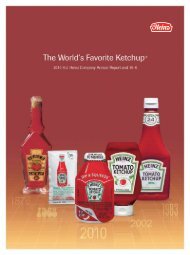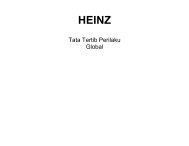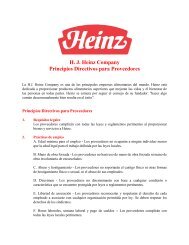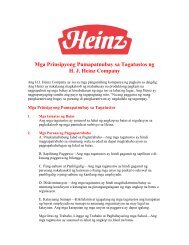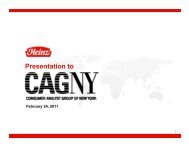ANYTIMEkANYPLACEkANYWHERE - Heinz
ANYTIMEkANYPLACEkANYWHERE - Heinz
ANYTIMEkANYPLACEkANYWHERE - Heinz
You also want an ePaper? Increase the reach of your titles
YUMPU automatically turns print PDFs into web optimized ePapers that Google loves.
In Fiscal 2000, the company repurchased 12.8 million shares of common stock, or 3.6% of<br />
the amount outstanding at the beginning of Fiscal 2000, at a cost of $511.5 million compared to<br />
the repurchase of 7.5 million shares, or 2.1% of the amount outstanding at the beginning of<br />
Fiscal 1999, at a cost of $410.1 million in Fiscal 1999. On June 1, 1999, the company completed<br />
the 10.0 million share repurchase program which was authorized by the Board of Directors<br />
on September 10, 1997. On June 9, 1999, the Board of Directors authorized the repurchase of<br />
up to 20.0 million shares. As of May 3, 2000, the company had repurchased 12.0 million shares<br />
of the 20.0 million share program. The company may reissue repurchased shares upon the<br />
exercise of stock options, conversions of preferred stock and for general corporate purposes.<br />
In Fiscal 2000, the cash requirements of Operation Excel were $479.4 million, consisting of<br />
spending for severance and exit costs ($89.3 million), capital expenditures ($173.6 million) and<br />
implementation costs ($216.5 million). The Fiscal 2000 cash requirements for Project Millennia<br />
were $29.1 million, consisting of spending for severance and exit costs ($19.6 million) and<br />
capital expenditures ($9.5 million). In Fiscal 1999, the cash requirements of Operation Excel<br />
were $75.6 million, consisting of spending for severance and exit costs ($16.6 million), capital<br />
expenditures ($5.8 million) and implementation costs ($53.2 million). The Fiscal 1999 cash<br />
requirements for Project Millennia were $117.4 million, consisting of spending for severance<br />
and exit costs ($48.6 million), capital expenditures ($46.5 million) and implementation costs<br />
($22.3 million). In Fiscal 2001, the company expects the cash requirements of Operation Excel<br />
to be approximately $413 million, consisting of severance and exit costs ($104 million of the<br />
$125.2 million accrued at May 3, 2000), capital expenditures ($159 million) and implementation<br />
costs ($150 million). The company is financing the cash requirements of these programs<br />
through operations, proceeds from the sale of non-strategic assets and with short-term and<br />
long-term borrowings. The cash requirements of Operation Excel will not have a significant<br />
impact on the company’s liquidity or financial position.<br />
During 1995, the company participated in the formation of a business (‘‘the entity’’) which<br />
purchases a portion of the trade receivables generated by the company. The company sells<br />
receivables to Jameson, Inc., a wholly owned subsidiary, which then sells undivided interests<br />
in the receivables to the entity. Outside investors contributed $95.4 million in capital to the<br />
entity. The company consolidates the entity, and the capital contributed by outside investors is<br />
classified as minority interest (other long-term liabilities) on the Consolidated Balance Sheets.<br />
In June 1998, the Financial Accounting Standards Board (the ‘‘FASB’’) issued Statement<br />
of Financial Accounting Standards (‘‘SFAS’’) No. 133, ‘‘Accounting for Derivative Instruments<br />
and Hedging Activities.’’ This statement establishes accounting and reporting standards for<br />
derivative instruments. The statement requires that an entity recognize all derivatives as either<br />
assets or liabilities in the statement of financial position and measure those instruments at fair<br />
value. In June 1999, the FASB issued SFAS No. 137, ‘‘Accounting for Derivative Instruments<br />
and Hedging Activities – Deferral of the Effective Date of FAS Statement 133,’’ which postponed<br />
the adoption date of SFAS No. 133. As such, the company is not required to adopt the statement<br />
until Fiscal 2002. In June 2000, the FASB issued SFAS No. 138, ‘‘Accounting for Certain<br />
Derivative Instruments and Certain Hedging Activities – an Amendment of FASB Statement<br />
No. 133.’’ This statement amends the accounting and reporting standards of SFAS No. 133<br />
for certain derivative instruments and certain hedging activities. The company is currently<br />
evaluating the effect that implementation of the new standard will have on its results of<br />
operations and financial position.<br />
(41)





